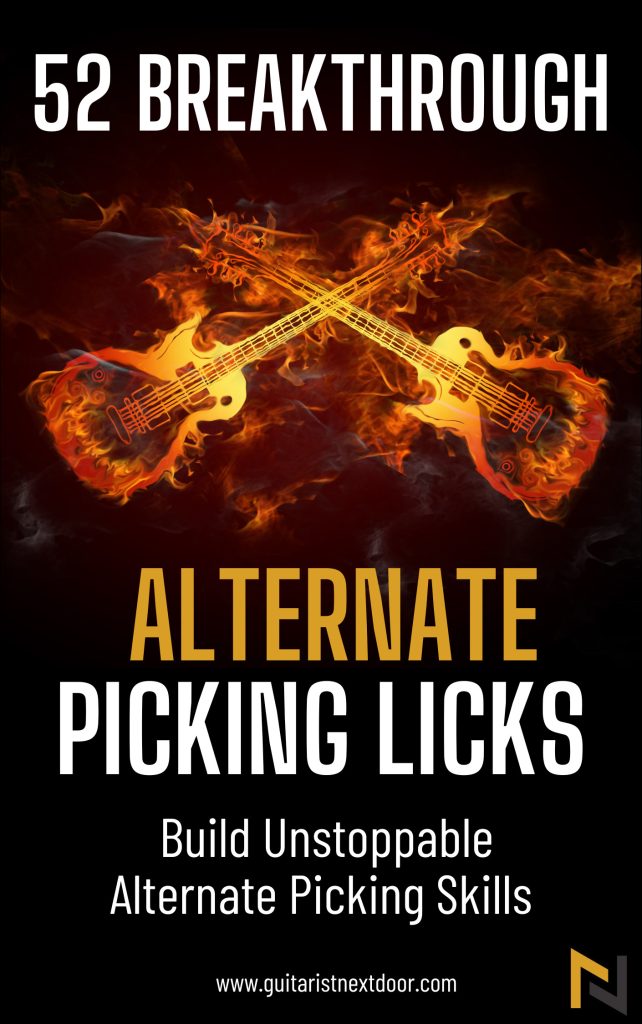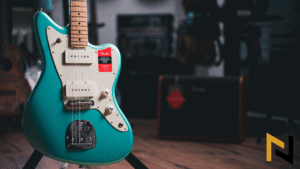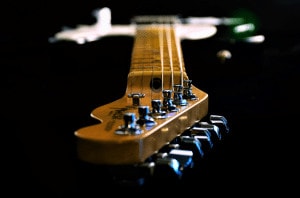
Author: Tyler Connaghan
Tyler Connaghan is a guitarist, singer, producer, composer & engineer based in Los Angeles, California. Tyler has been playing the guitar since 2007. In between writing for guitar publications, he produces music for film and television. His favorite axe is his custom Pelham Blue Fender Stratocaster.
Expertise: music industry, producing, acoustic & electric guitars, songwriting
Bachelor of Science in Music Industry Studies, Music Industry

Editor: Edward Bond
Edward has been playing the guitar since 2002. So Edward has over 20 years of experience as a guitarist, has authored 15 guitar books, has written for renowned music blogs, and spent a decade teaching music. He began merging his passion for writing and music in 2020 and has written for big guitar websites such as Guitar Head Publishing and KillerGuitarRigs.com.
Originally from Seattle, Edward moved to Norway in 2021 for a master’s in music. He’s studied at the Jazz Institute Berlin and Conservatorium van Amsterdam, and currently resides in Trondheim. His education includes a European Jazz Master’s, a diploma in Film and Game Scoring from Sofia, and a Bachelor’s in Jazz from University of Oregon.
Edward has played in numerous bands and currently, Edward works on his own project Starship Infinity
Since the dawn of the electric guitar, we’ve witnessed everything from the great pioneers of rock ‘n’ roll like Chuck Berry to jazz virtuosos like Lee Ritenour. Interestingly enough, many of the greats started out with Gibsons.
Gibson’s influence on guitar history is undeniably important. If you’ve been playing guitar for long, you’ve likely been taken aback by the beauty of high-end Gibson guitars, though for most hobby musicians, most Gibson models are overshadowed by the iconic Les Paul.
Today, we will compare two of Gibson’s most legendary semi-hollowbody guitars — the Gibson ES-335 and the Gibson ES-339. For many years, I’ve been a massive fan of Gibson’s semi-hollowbody line. Beyond the warmth, resonance, and tonality these pieces of art provide, they also have some of the deepest histories in the world of guitars.
Whether you’re a full-fledged rock ‘n’ roll player or a burgeoning blues virtuoso, allow me to guide you as we explore the ins and outs of two of my favorite semi-hollowbodies.
Gibson ES-335 vs ES-339: A Head-to-Head Comparison
Summary (if you’re in a hurry!)
Quick Background
- Gibson ES-335: The iconic Gibson ES-335 made its debut in 1958. With its unique semi-hollowbody, double-cutaway, arched top design, complete with f-holes, it’s one of the most instantly recognizable guitars in the Gibson lineup.
- Gibson ES-339: The Gibson ES-339 is a 2007 re-up of the old-school ES-335 with a smaller build and a more versatile tonal range.


*Consider all links in this post to be affiliate links. If you purchase, at no additional cost to you, we may earn a small commission. It helps us to keep the lights on, thanks! 🙂
Imagine Having The Technique, Gear, and Sound of The GOATS… But Don’t just imagine. Find out.
Joe Satriani
Main Band
Solo Artist
Main Guitar
Ibanez Joe Satriani Signature JS2480
Joe Satriani
| Uniqueness | (4.5) |
| Accuracy | (5.0) |
| Speed | (5.0) |
| Right Hand | (5.0) |
| Techniques | (5.0) |
| Versatility | (3.5) |
| Performance | (4.5) |
| Overall Lead | (5.0) |
| Overall Rhythm | (4.5) |
Tommy Emmanuel
Main Band
Solo Artist
Main Guitar
Maton TE Personal
Tommy Emmanuel
| Uniqueness | (3.5) |
| Accuracy | (4.5) |
| Speed | (5.0) |
| Right Hand | (5.0) |
| Techniques | (5.0) |
| Versatility | (4.0) |
| Performance | (4.0) |
| Overall Lead | (5.0) |
| Overall Rhythm | (5.0) |
Steve Vai
Main Band
Solo Artist
Main Guitar
Ibanez Steve Vai JEM77
Steve Vai
| Uniqueness | (4.5) |
| Accuracy | (5.0) |
| Speed | (5.0) |
| Right Hand | (4.5) |
| Techniques | (5.0) |
| Versatility | (3.0) |
| Performance | (4.5) |
| Overall Lead | (5.0) |
| Overall Rhythm | (4.5) |
Similarities
- Body Construction: These guitars use semi-hollowbody designs with laminated maple throughout and a solid maple center block.
- Necks: Both guitars feature glued-in set mahogany necks and rosewood fingerboards.
- Hardware: Both guitars use a LockTone Tune-O-Matic bridge, black “top hat” control knobs, and a floating black five-ply pickguard.
Differences
- Size: The ES-339 body size is smaller at 14 inches, while the ES-335 runs 16 inches.
- Tuners: The ES-339 has Grover Rotomatics tuners, while the ES-335 has vintage Deluxe Keystone tuners.
- Jack: The ES-339 has a side-mounted jack, while the ES-335 has a top-mounted jack.
- Color Options – The ES-335 is available in Vintage Sunburst, Sixties Cherry, Vintage Ebony, Iced Tea, or Antique Natural finishes. The ES-339 is available in Cherry and Sixties Cherry, Transparent Ebony, and Blueberry Burst.
- Pickups: While both guitars use a variety of pickups depending on the exact model and year, current factory models feature the popular Calibrated T-type Rhythm and Lead Humbucker pickups on the ES-335 and 57 Classic and 57 Classic+ Humbucker pickups on the ES-339.
When to Choose the Gibson ES-335?
If you’re looking for a classic, full-bodied vintage sound that’s great for rock, blues, or jazz, the Gibson ES-335 is the way to go.
When to Choose the Gibson ES-339?
If you’re in the market for a lighter, more modernized version of the ES-335 with a brighter overall tone, the ES-339 is a great choice.
Are you still trying to decide which of these great axes is right for you?
Let’s explore them in greater detail!
Key Specs for Both Guitars
| Gibson ES-335 | Gibson ES-339 | |
|---|---|---|
| Body Shapes | Double-cutaway semi-hollowbody | Double-cutaway semi-hollowbody |
| Body Size | 16” | 14” |
| Tonewoods | Maple body, top, back, and sides with a mahogany neck | Maple body, top, back, and sides with a mahogany neck |
| Neck Profiles | Glued-in rounded C-profile | Glued-in rounded C-profile |
| Pickups | 2 Calibrated T-Type pickups | 2 Classic 57 pickups |
| Frets | 22 medium jumbo frets | 22 medium jumbo frets |
| Bridge | ABR-1 Tune-O-Matic Bridge with Aluminum Stopbar | ABR-1 Tune-O-Matic Bridge with Aluminum Stopbar |
| Tuners | Vintage Deluxe Keystone tuners | Grover Rotomatics |
| Color Options | Vintage Sunburst, Sixties Cherry, Vintage Ebony, Iced Tea, Antique Natural | Cherry and Sixties Cherry, Transparent Ebony, Blueberry Burst |
| Price | $2,999 to $3,999 | $2,999 to $3,499 |
| Variants | ES-335 Figured, ES-335 Satin, ES-335 Vintage Burst | ES-339 Standard and ES-339 Figured |
Design & Body Dimensions
The table below displays the basic body dimensions of the ES-335 and ES-339:
| Gibson ES-335 | Gibson ES-339 | |
|---|---|---|
| Body Length | 19.25 inches | 17.375 inches |
| Body Width | 16.5 inches | 13.25 inches |
| Body Depth | 1.75 inches | 1.75 inches |
| Scale Length | 24.75 inches | 24.75 inches |
| Weight | Model and year-dependent | Model and year-dependent |
Materials & Hardware
As our summary pointed out, these two Gibson semi-hollow guitars share much in common regarding the materials and hardware they’re crafted from. Even so, a few subtle differences are worth pointing out.
Body Construction
The anatomy of an electric guitar starts at the body, and both the ES-335 and ES-339 take advantage of the semi-hollowbody design. A solid maple center block runs through the length of each guitar, minimizing the feedback you get from a traditional hollowbody guitar.
By the way, Anderton’s wrote up an excellent hollow-body vs. semi-hollow comparison guide, which is worth checking out if you want to learn the differences between the two.
You’ll also find a double-cutaway shape for the bodies. Beyond making the guitars more comfortable to play, the double-cutaway provides a bit more accessibility to the upper fret range. As for the actual Gibson guitar tones, one of the most defining characteristics of these guitars is the f-hole design. These f-holes allow sound to resonate from the bodies, delivering a deep, complex tone.
Body size is where things start to differ.
The Gibson ES-335 has a slightly larger body, meaning you’ll get more of that classic hollowbody sound you’re used to.
On the other hand, the ES-339 body shape is trimmed down, making it lighter and easier to travel with, which I prefer.
Neck
Each guitar uses a glued-on mahogany neck, balancing out the maple body with a little bit of warmth. Though the Rounded C neck profile is the current standard for each guitar, some vintage ES-335 models feature a Slim Taper neck profile, which is excellent if you have smaller hands or are looking for a slightly easier guitar to play. However, this is not a current factory specification.
Pickups
The Calibrated T-Type Rhythm and Lead pickups are stock on the Gibson ES-335, while the Classic 57 and 57+ pickups are Gibson’s choice for the Gibson ES-339.
| Calibrated T-Types | Brighter and more transparent with a distinctive twang. |
| Classic 57 and 57+ | Offers the same vintage warmth from Alnico Classic Pros with a bit more clarity. The difference between the 57 and 57+ pickups is that the latter has a slightly higher output. |
Overall, this Gibson guitar series offers more body and warmth regarding tone than you would find in a guitar with single-coil pickups.
Check out our recent article – “Why Are Guitar Pickups So Expensive?”
Playability & Comfort
Both the ES-335 and 339 use rounded-C neck profiles. They also share the same rosewood fingerboard material and 24.75” scale length, so the comfort level is pretty much the same in terms of fretting.
The main difference between the two is the body size and weight. Because ES-335s are larger, they’re also heavier, meaning multi-hour gigs or sessions can be slightly more uncomfortable than if you had a 339.
In terms of playing ease, the ES-339 takes the cake!
Sound Comparison
These guitars sound very similar in many ways, as they share many of the same features and characteristics. However, with slightly different dimensions and pickups, there are a few notable tonal differences.
The smaller body on the ES-339 provides a more focused sound, while the ES-335 gives you that full-sized semi-hollowbody tone. Of course, the pickups play a pretty large role in the matter, too, with the Calibrated T-Types offering a somewhat brighter tone on the 335, balancing out the large, warm body sound, while the Classic 57s on the ES-339 make it a bit more aggressive.
Overall, the 339 is more suited to modern styles of music, including pop, rock, and even blues. With a smaller, less-resonant body, it offers more versatility than the larger 335, which is better for older jazz, country, blues, and rock styles.
Gibson ES-335 vs. 339: Pricing
Though there are many limited edition models, special release models, and models that are no longer in production, let’s keep things simple and look at what you can expect in terms of pricing for the most current popular models in the ES-335 and ES-339 lineup.
| Gibson ES-335 Figured | $3,999 |
| Gibson ES-335 Vintage Burst | $3,499 |
| Gibson ES-335 Satin | $2,999 |
| Gibson ES-339 Figured | $3,499 |
| Gibson ES-339 Standard | $2,999 |
Regarding the overall value of what you get from these guitars, it’s worth asking yourself what you’re paying for, as they all hover around the same price point.
It’s worth noting that the main differences between the various ES-335 and ES-339 are purely aesthetic. For example, the ES-335 Satin has a satin top on the body, while the ES-335 does not, giving it a more “raw” feel. Among the various ES-335 and ES-339 models, all other features remain the same.
If we’re talking about an objective value comparison of what you get for your money, I’d say the winner is the standard ES-339.
Gibson ES-335 vs. ES-339 – Pros and Cons
Gibson ES-335
| Gibson ES-335 Pros | Gibson ES-335 Cons |
|---|---|
| Full-Bodied Sound: With a larger body, you get a fuller sound. | Large: The added weight and size might make some players a bit more uncomfortable. |
| Vintage Gibson Guitar Aesthetics: The ES-335 is a timeless guitar, and Gibson gives us access to that timelessness, even in the new iterations. | |
| Resonant: Even unplugged, this thing sounds incredible! |
Gibson ES-339
| Gibson ES-339 Pros | Gibson ES-339 Cons |
|---|---|
| Lightweight: With a smaller build, it’s an easier guitar to play for hours on end than the 335. | Less Resonant: You don’t get as much warmth and sustain from the ES-339 as the ES-335, and some semi-hollowbody lovers might find it lacking. |
| Modern Sound: I love the modern tone on the ES-339. It’s a bit more versatile than the 335 for contemporary music. | |
| Playability: With a small body and smooth neck, the playability is off the charts. |
Conclusion
There you have it, our Gibson guitars comparison!
When all is said and done, the biggest takeaway from this Gibson ES-335 vs. 339 comparison guide should be that these guitars are both excellent choices, even with the nuanced shape and tone differences.
However, if I were to pick one, I’d go for the ES-339, just because I love a modern workhorse guitar with built-in versatility. Make sure to explore our guide to the best Gibson acoustic guitars if you’re looking to expand your arsenal even further!
FAQs
Are Gibson Electric Guitars Any Good?
Absolutely. Gibson is one of the best guitar brands worldwide.
What Is The Difference Between A Gibson ES-335 and ES-339?
The primary difference between the Gibson ES-335 and 339 is the size of the body. The 339 is slightly smaller.
Which Is Bigger, ES-335 or ES-339?
The ES-335 is the slightly larger of the two Gibson electric guitars.
Do The Gibson ES-339 and ES-335 Sound Similar?
While they sound similar in many ways, you get slightly more resonance out of the 335 thanks to the larger body, which gives it a warmer sound.
Does An ES-339 Sound Like A Les Paul?
Though it might not sound exactly like a Les Paul, the mahogany neck and humbucker pickups offer some similarities between the two in terms of tone.
Is A Gibson ES-339 Worth The Money?
If you’re looking for a high-end semi-hollowbody guitar that’s ultra-versatile, then yes, it’s definitely worth the investment!
Which Is More Versatile, ES-335 Or ES-339?
The ES-339 offers more versatility with a brighter, more modern sound, making it suitable for a wide range of contemporary genres.
Which Gibson ES Model Is The Best?
While neither the ES-335 nor the ES-339 is the “best,” as that rating comes down to personal preference, I like the 339 better simply because it’s more versatile.
What’s The Difference Between An Epiphone ES-335 And A Gibson ES-335?
Gibson ES guitars and all other Gibson guitar models are made in the United States with the highest-quality materials and expert craftsmanship. In contrast, Epiphones are made overseas with cheaper materials and electronics. The difference between Gibson and Epiphone is build quality, and I often like to think of Epiphones as cheap Gibson guitars.
What Artists Used Gibson ES Guitars?
Some of the top Gibson ES Series artists include:
- Chuck Berry
- B.B. King
- Eric Clapton
- Warren Haynes
- Alvin Lee
- Larry Carlton
- Dave Grohl
















